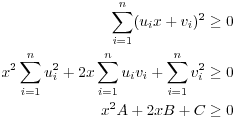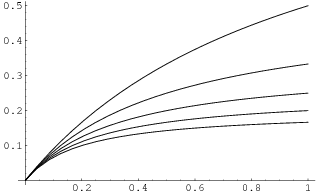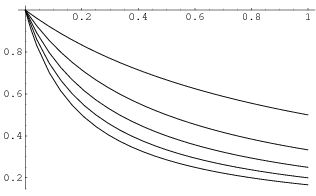Definition. If X is a set, a metric on X is a function ![]() such that:
such that:
(a) ![]() for all
for all ![]() ;
; ![]() if and only if
if and only if
![]() .
.
(b) ![]() for all
for all ![]() .
.
(c) ( Triangle Inequality) For all ![]() ,
,
![]()
Lemma. Let X be a set with a metric, and consider the set of open balls of the form
![]()
The set ![]() for all
for all ![]() and all
and all ![]() forms a basis for a topology on X.
forms a basis for a topology on X.
Proof. If ![]() , then
, then ![]() .
.
Suppose ![]() and
and ![]() are open balls. Let
are open balls. Let
![]() .
.
Let
![]()
Then ![]() . Therefore, the collection of open balls forms a
basis.
. Therefore, the collection of open balls forms a
basis.![]()
Definition. If X is a set with a metric, the
metric topology on X is the topology generated
by the basis consisting of open balls ![]() , where
, where
![]() and
and ![]() .
.
A metric space consists of a set X together with a metric d, where X is given the metric topology induced by d.
Remark. In generating a metric topology, it suffices to consider balls of rational radius.
Example. Let ![]() and
and ![]() be elements of
be elements of ![]() , and define
, and define

This gives the standard or
Euclidean metric on ![]() .
.
It is clear that ![]() and that
and that ![]() for all
for all ![]() . If
. If ![]() and
and ![]() and
and ![]() , then
, then

This is only possible if ![]() for all i, and this in turn
implies that
for all i, and this in turn
implies that ![]() for all i. Therefore,
for all i. Therefore, ![]() .
.
It is obvious that ![]() for all
for all ![]() .
.
Note that ![]() , where
, where ![]() is the standard
norm which gives the length of a vector. Now
is the standard
norm which gives the length of a vector. Now ![]() , where
, where
![]() denotes the dot product in
denotes the dot product in ![]() . By standard
properties of the dot product,
. By standard
properties of the dot product,
![]()
(The inequality follows from the Schwarz
inequality ![]() .) Then
.) Then
![]()
Now let ![]() and
and ![]() . Then
. Then
![]()
Here is a proof of the Schwarz inequality in case you ahven't seen
it. Given ![]() , I want to show that
, I want to show that ![]() ; I'll show that
; I'll show that ![]() , and the result will follow by taking
square roots.
, and the result will follow by taking
square roots.
Set ![]() ,
, ![]() , and
, and ![]() . I want to show that
. I want to show that
![]() .
.
If ![]() , then
, then ![]() , and the result is obvious. Assume then
that
, and the result is obvious. Assume then
that ![]() . For all
. For all ![]() ,
,

Take ![]() . The last inequality yields
. The last inequality yields

This completes the proof of the Schwarz inequality.
Thus, the standard metric on ![]() satisfies the axioms for a metric.
Obviously, the metric topology is just the standard topology.
satisfies the axioms for a metric.
Obviously, the metric topology is just the standard topology.![]()
Lemma. ( Comparison Lemma
for Metric Topologies) Let d and ![]() be metrics on X
inducing topologies
be metrics on X
inducing topologies ![]() and
and ![]() .
. ![]() is finer than
is finer than
![]() if and only if for all
if and only if for all ![]() and
and ![]() , there is a
, there is a ![]() such that
such that ![]() .
.
Proof. Suppose first that ![]() . Let
. Let ![]() , and let
, and let ![]() .
. ![]() is open in
is open in ![]() , so it's open
in
, so it's open
in ![]() . Since the open d-balls form a basis for
. Since the open d-balls form a basis for ![]() , there is an open ball
, there is an open ball ![]() such that
such that
![]()
Conversely, suppose that for all ![]() and
and ![]() , there is a
, there is a
![]() such that
such that ![]() . I want to show that
. I want to show that ![]() .
.
Let U be open in ![]() . I want to show that it's open in
. I want to show that it's open in ![]() . Let
. Let ![]() . Since the
. Since the ![]() -balls form a basis for
-balls form a basis for ![]() , there is an
, there is an ![]() such that
such that
![]()
By assumption, there is a ![]() such that
such that
![]()
Therefore, ![]() .
.
Now ![]() is a
is a ![]() -open set containing x and
contained in U. Since
-open set containing x and
contained in U. Since ![]() was arbitrary, U is open in
was arbitrary, U is open in ![]() . Therefore,
. Therefore, ![]() .
.![]()
The standard metric on ![]() is unbounded, in the sense that
you can find pairs of points which are arbitrarily far apart.
However, you can always replace a metric with a bounded
metric which gives the same topology.
is unbounded, in the sense that
you can find pairs of points which are arbitrarily far apart.
However, you can always replace a metric with a bounded
metric which gives the same topology.
Definition. If ![]() is a metric space
and
is a metric space
and ![]() , then Y is bounded if there
is an
, then Y is bounded if there
is an ![]() such that
such that
![]()
Lemma. Let X be a metric space with metric d. Define
![]()
(a) ![]() is a metric.
is a metric.
(b) d and ![]() induce the same topology on X.
induce the same topology on X.
Proof. (a) Let ![]() . Since
. Since ![]() ,
, ![]() , and
, and
![]()
If ![]() , then
, then ![]() , so
, so ![]() . This shows that the first metric axiom
holds.
. This shows that the first metric axiom
holds.
Since ![]() , the second metric axiom holds.
, the second metric axiom holds.
To verify the third axiom, take ![]() . Begin by noting that
if either
. Begin by noting that
if either ![]() or
or ![]() , then
, then ![]() or
or ![]() . Therefore,
. Therefore,
![]()
Assume that ![]() and
and ![]() . Then
. Then
![]()
This verifies the third axiom, so ![]() is a metric.
is a metric.
(b) Observe that for ![]() ,
, ![]() . The idea is to apply the Comparison
Lemma, shrinking balls if necessary to make their radii less than 1.
. The idea is to apply the Comparison
Lemma, shrinking balls if necessary to make their radii less than 1.
Let ![]() and let
and let ![]() .
.
If ![]() , then
, then ![]() .
.
If ![]() , then
, then
![]()
Therefore, the d-topology is finer than the ![]() -topology. The other
inclusion follows by simply swapping the d's and
-topology. The other
inclusion follows by simply swapping the d's and ![]() 's.
's.![]()
It follows that boundedness is not a topological notion, since every subset is bounded in the standard bounded metric.
Example. The square
metric on ![]() is given by
is given by
![]()
Relative to this metric, ![]() is an n-cube centered
at x with sides of length
is an n-cube centered
at x with sides of length ![]() .
.
First, I'll show that ![]() is a metric. Let
is a metric. Let ![]() .
.
Clearly, ![]() and
and ![]() . If
. If ![]() , then
, then ![]() for all i, so
for all i, so ![]() .
.
It's also obvious that ![]() .
.
If ![]() , then for each j,
, then for each j,
![]()
Therefore,
![]()
Thus, ![]() is a metric.
is a metric.![]()
Lemma. ![]() induces the same topology on
induces the same topology on ![]() as the standard metric.
as the standard metric.
Proof. The idea of the proof is depicted below.

Note that


These inequalities may be used to get ![]() -balls contained in
d-balls and d-balls contained in
-balls contained in
d-balls and d-balls contained in ![]() -balls; by the
Comparison Lemma, this shows that the topologies are the same.
-balls; by the
Comparison Lemma, this shows that the topologies are the same.![]()
Lemma. The square metric induces the product
topology on ![]() .
.![]()
Proof. If ![]() , then
, then
![]()
The set on the right is open in the product topology. Since the square metric-basic sets are open in the product topology, any square metric-open set is open in the product topology.
Conversely, let
![]()
It is easy to check that sets of this form comprise a basis for the product topology.
Let ![]() , so
, so ![]() for all i.
Define
for all i.
Define
![]()
Then
![]()
So
![]()
It follows that U is open in the square metric topology. Since the
product topology basic sets are open in the square metric topology,
any product topology open set is open in the square metric
topology.![]()
Lemma. Metric topologies are Hausdorff.
Proof. Let ![]() be a metric space,
and let x and y be distinct points of X. Let
be a metric space,
and let x and y be distinct points of X. Let ![]() . Then
. Then
![]() and
and ![]() are disjoint open sets in the metric topology which
contain x and y, respectively.
are disjoint open sets in the metric topology which
contain x and y, respectively.![]()
Lemma. If ![]() ,
, ![]() are metric spaces, the
are metric spaces, the ![]() definition
of continuity is valid. That is, a map
definition
of continuity is valid. That is, a map ![]() is continuous
at
is continuous
at ![]() if and only if for every
if and only if for every ![]() , there is a
, there is a
![]() such that if
such that if ![]() implies that
implies that ![]() .
.
Proof. First, suppose that ![]() is continuous at
is continuous at ![]() . Let
. Let ![]() , and
consider the ball
, and
consider the ball ![]() . Since this is an open set
containing
. Since this is an open set
containing ![]() , continuity implies that there is a
, continuity implies that there is a ![]() such that
such that
![]()
Now consider the conclusion to be established. Suppose ![]() satisfies
satisfies ![]() . Then
. Then ![]() , so
, so ![]() .
Therefore,
.
Therefore, ![]() , so
, so ![]() .
.
Conversely, suppose that for every ![]() , there is a
, there is a
![]() such that if
such that if ![]() implies that
implies that ![]() . I want to show that f is continuous.
. I want to show that f is continuous.
Let ![]() , and let V be an open set in Y containing
, and let V be an open set in Y containing ![]() .
I want to find a neighborhood U of x such that
.
I want to find a neighborhood U of x such that ![]() .
.
Since the ![]() -balls form a basis for the metric topology, I may
find an
-balls form a basis for the metric topology, I may
find an ![]() such that
such that ![]() . By assumption, there is a
. By assumption, there is a ![]() such that if
such that if
![]() implies that
implies that ![]() .
.
Now consider the ball ![]() . This is an open set containing
x. If
. This is an open set containing
x. If ![]() , then
, then ![]() .
Therefore,
.
Therefore, ![]() , so
, so ![]() . This shows that
. This shows that ![]() , so f is continuous.
, so f is continuous.![]()
Definition. If X is a set, a sequence in X is a function ![]() .
.
It's customary to write ![]() for
for ![]() in this situation, and to abuse
terminology by referring to the collection
in this situation, and to abuse
terminology by referring to the collection ![]() as "the
sequence".
as "the
sequence".
Definition. Let X be a topological space. A
sequence ![]() converges to a point
converges to a point ![]() if for every neighborhood U of x, there is an integer
N such that
if for every neighborhood U of x, there is an integer
N such that ![]() for all
for all ![]() .
.
![]() means that
means that ![]() converges to x.
converges to x.
Lemma. Let X be a Hausdorff space. Convergent sequences converge to unique points.
Proof. Let ![]() and
and ![]() . I want to show that
. I want to show that ![]() .
.
Suppose ![]() . Since X is Hausdorff, I can find disjoint
neighborhoods U of x and V of y. Since
. Since X is Hausdorff, I can find disjoint
neighborhoods U of x and V of y. Since ![]() , I can find an
integer M such that
, I can find an
integer M such that ![]() implies
implies ![]() . Since
. Since ![]() , I can find an integer N such that
, I can find an integer N such that ![]() implies
implies ![]() . Therefore, for
. Therefore, for ![]() , I have
, I have ![]() . This is
nonsense, so
. This is
nonsense, so ![]() .
.![]()
In particular, limits of sequences are unique in metric spaces.
Lemma. ( The Sequence
Lemma) Let X be a topological space, let ![]() , and let
, and let ![]() . If there is a sequence
. If there is a sequence ![]() with
with ![]() for all n and
for all n and ![]() , then
, then ![]() . The converse is true if X is a
metric space.
. The converse is true if X is a
metric space.
Proof. Suppose that there is a sequence ![]() with
with ![]() for all n and
for all n and ![]() . Let U be a neighborhood of x. Find an integer N
such that
. Let U be a neighborhood of x. Find an integer N
such that ![]() for all
for all ![]() . Obviously, U meets Y.
This proves that
. Obviously, U meets Y.
This proves that ![]() .
.
Conversely, suppose that X is a metric space and ![]() . For each
. For each ![]() , the ball
, the ball ![]() meets Y, so I may choose
meets Y, so I may choose ![]() . I claim that
. I claim that ![]() .
.
Let U be a neighborhood of x. Since the open balls form a basis for
the metric topology, I may find ![]() such that
such that
![]() ; then I may find
; then I may find ![]() such that
such that
![]() , so
, so ![]() .
.
For all ![]() , I have
, I have ![]() , so
, so ![]() . Since
. Since ![]() , I have
, I have ![]() for all
for all ![]() .
.
This proves that ![]() .
.![]()
Theorem. Let X be a metric space, let Y be a
topological space, and let ![]() . f is continuous if and only
if
. f is continuous if and only
if ![]() in X implies that
in X implies that ![]() in Y.
in Y.
More succinctly, continuous functions carry convergent sequences to convergent sequences.
Proof. Suppose f is continuous, and suppose
![]() in X. Let V be a neighborhood of
in X. Let V be a neighborhood of ![]() in Y. By continuity, there is a neighborhood U of x such that
in Y. By continuity, there is a neighborhood U of x such that ![]() .
.
Since ![]() , there is an integer N such that
, there is an integer N such that ![]() for all
for all ![]() . Then
. Then ![]() for all
for all ![]() . This proves that
. This proves that ![]() .
.
Conversely, suppose that ![]() in X implies that
in X implies that ![]() in Y. To show f is continuous, it will suffice to
show that for all
in Y. To show f is continuous, it will suffice to
show that for all ![]() , I have
, I have ![]() .
.
Thus, take ![]() . I want to show that
. I want to show that ![]() .
.
Now X is a metric space and ![]() , so by the Sequence
Lemma, there is a sequence of points
, so by the Sequence
Lemma, there is a sequence of points ![]() with
with
![]() . By hypothesis, this implies that
. By hypothesis, this implies that ![]() . Since
. Since ![]() is a sequence in
is a sequence in ![]() ,
the Sequence Lemma implies that
,
the Sequence Lemma implies that ![]() . Therefore, f is
continuous.
. Therefore, f is
continuous.![]()
Definition. Let ![]() be a
sequence of functions from X to Y, where Y is a metric space.
be a
sequence of functions from X to Y, where Y is a metric space. ![]() converges uniformly to a
function
converges uniformly to a
function ![]() if for every
if for every ![]() , there is an
integer N such that
, there is an
integer N such that
![]()
Theorem. Let ![]() be a
sequence of continuous functions from X to Y, where Y is a metric
space. If
be a
sequence of continuous functions from X to Y, where Y is a metric
space. If ![]() converges uniformly to
converges uniformly to ![]() , then f is
continuous.
, then f is
continuous.![]()
This is often expressed by saying that a uniform limit of continuous functions is continuous.
Proof. Let ![]() and let
and let ![]() be a neighborhood of
be a neighborhood of ![]() . I want to find a
neighborhood U of a such that
. I want to find a
neighborhood U of a such that ![]() .
.
First, uniform continuity implies that there is an integer N such that
![]()
In particular,
![]()
![]() is continuous, so there is a neighborhood U of a such
that
is continuous, so there is a neighborhood U of a such
that ![]() .
Thus,
.
Thus,
![]()
Moreover, restricting (*) to ![]() and
and ![]() , I have
, I have
![]()
Therefore, the triangle inequality implies that
![]()
for all ![]() .
.
This proves that f is continuous.![]()
Example. For ![]() , let
, let
![]() be defined by
be defined by
![]()
For fixed x, ![]() .
Thus, this sequence of functions converges pointwise to the constant
function 0.
.
Thus, this sequence of functions converges pointwise to the constant
function 0.
The picture below shows the graphs of ![]() for
for ![]() on the interval
on the interval ![]() .
.

I will show that the convergence is uniform on the interval ![]() . Thus, choose
. Thus, choose ![]() ; I must find
an integer N such that if
; I must find
an integer N such that if ![]() , then
, then
![]()
Since ![]() ,
, ![]() is
an increasing function;
is
an increasing function; ![]() , so it follows
that
, so it follows
that
![]()
Now choose N such that ![]() . Then if
. Then if ![]() ,
,
![]()
This proves that ![]() converges uniformly to 0 on
converges uniformly to 0 on ![]() .
.![]()
Example. For ![]() , let
, let
![]() be defined by
be defined by
![]()
For fixed ![]() ,
, ![]() . Thus, this sequence of functions converges
pointwise to the constant function 0 for
. Thus, this sequence of functions converges
pointwise to the constant function 0 for ![]() . It converges
pointwise to 1 for
. It converges
pointwise to 1 for ![]() .
.
The picture below shows the graphs of ![]() for
for ![]() on the interval
on the interval ![]() .
.

I will show that the convergence is not uniform on the
interval ![]() . In fact, I will show that there is no
integer N such that if
. In fact, I will show that there is no
integer N such that if ![]() , then
, then
![]()
To see this, it suffices to note that ![]() , so there will always be a point in
, so there will always be a point in ![]() where the function exceeds
where the function exceeds ![]() .
.
Therefore, ![]() converges pointwise, but not uniformly, to
the zero function.
converges pointwise, but not uniformly, to
the zero function.![]()
Send comments about this page to: bikenaga@marauder.millersville.edu.
Last updated:
Millersville University Home Page
Copyright 2009 by Bruce Ikenaga